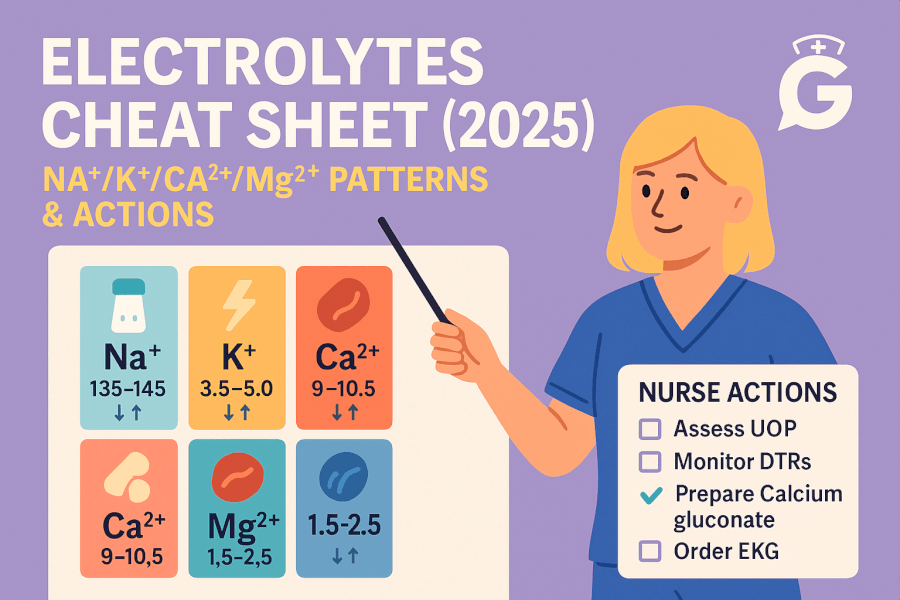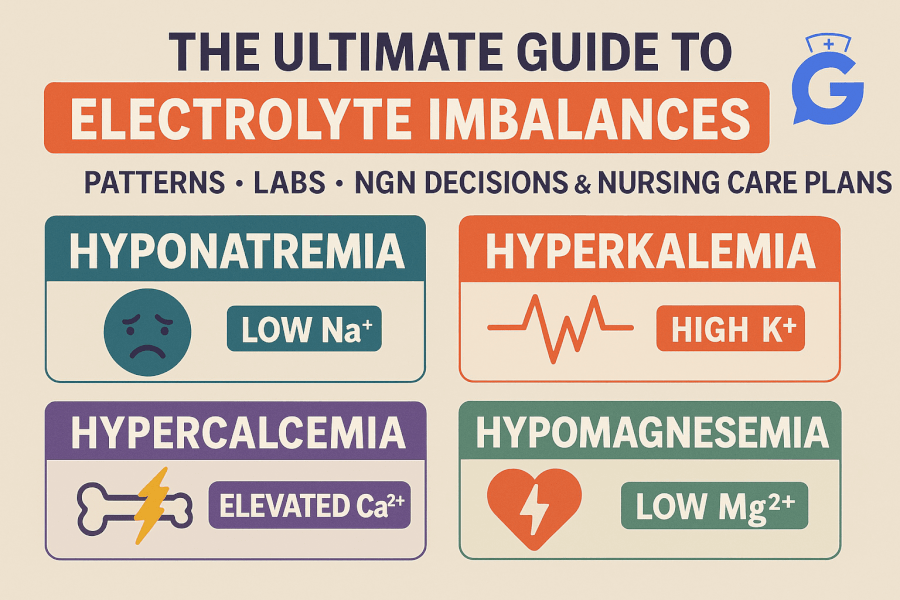A good electrolytes page should do two things: keep the ranges in reach and make the first actions obvious. This cheat sheet compresses sodium, potassium, calcium, and magnesium into tables, fast patterns, and nurse-priority steps you can use on NGN items and in clinicals.
If you need a broader context, keep Normal Lab Values (2025): Printable Cheat Sheet open. For acid–base questions tied to bicarbonate and ventilation, pair this with ABG Interpretation Made Simple (2025). If stems feel crowded, reset with How to Read NGN Case Stems (2025).
Table of Contents
- How to Use This Cheat Sheet
- Quick Reference Ranges
- Sodium (Na⁺)
- Potassium (K⁺)
- Calcium (Ca²⁺)
- Magnesium (Mg²⁺)
- Fast Patterns & When to Worry
- NGN Tie-Ins: Action → Parameter Pairs
- FAQs
- Further Reading
🎯 Free NCLEX quiz!
Test your knowledge - new quizzes added weekly!
How to Use This Cheat Sheet
- Check the range, then name the single priority in one sentence.
- Choose two actions that change physiology (oxygenation, perfusion, conduction, neuromuscular stability).
- Pick two parameters you’ll reassess soon (10–30 minutes when appropriate) to prove the actions worked.
- For mixed pictures, consult ABG Interpretation and trend.
Note: Ranges vary by lab, assay, and population. Always use your facility’s or course’s reference ranges.
Professor’s note: When two actions seem reasonable, pick the pair that changes physiology fastest and gives you a measurable parameter soon.
Quick Reference Ranges
| Electrolyte | Typical Adult Range* | High-Yield Notes |
|---|---|---|
| Sodium (Na⁺) | 135–145 mEq/L | Water balance & neurologic status; avoid rapid corrections |
| Potassium (K⁺) | 3.5–5.0 mEq/L | Cardiac conduction & muscle; ECG monitoring when abnormal |
| Calcium (total) | 8.6–10.2 mg/dL | Correct for albumin; ionized Ca²⁺ is most accurate for symptoms |
| Magnesium (Mg²⁺) | 1.7–2.2 mg/dL | Arrhythmias, neuromuscular stability, preeclampsia therapy |
*Verify your local reference ranges.
Sodium (Na⁺)
What it reflects: Water balance and brain function. Rapid shifts can cause severe neurologic symptoms.
| Status | Common Causes | Priority Signs | Nurse Actions | Parameters to Reassess |
|---|---|---|---|---|
| Hyponatremia (<135) | Diuretics, SIADH, excess free water, GI losses | Headache, confusion, seizures (acute drop) | Neuro checks; manage fluids per protocol; treat cause; avoid rapid correction | Na⁺ trend; mental status; seizure activity; serum osmolality |
| Hypernatremia (>145) | Water loss (fever, diarrhea), DI, inadequate intake | Thirst, dry mucosa, lethargy, irritability | Assess volume; replace water gradually; treat cause | Na⁺ trend; mentation; IOs; vital signs |
Pearls
- Symptomatic, rapid-onset hyponatremia is a neuro emergency—escalate per protocol.
- Correct chronic hyponatremia slowly to reduce risk of osmotic demyelination.
Potassium (K⁺)
What it reflects: Cardiac conduction and muscle function. Small deviations can be dangerous.
| Status | Common Causes | Priority Signs | Nurse Actions | Parameters to Reassess |
|---|---|---|---|---|
| Hyperkalemia (≥5.5 or ECG changes) | Renal failure, ACE/ARB, K⁺-sparing diuretics, hemolysis | Peaked T waves, weakness, arrhythmias | Cardiac monitor; stabilize myocardium per protocol; shift K⁺ into cells (insulin + dextrose/β-agonist); remove K⁺ (diuretics/resin/dialysis as ordered) | ECG; K⁺ recheck; mentation; vital signs |
| Hypokalemia (<3.5) | Diuretics, vomiting, diarrhea, insulin therapy, alkalosis | Flat T waves, U waves, cramps, ileus | Cardiac monitor; replace K⁺ per protocol; check Mg²⁺ (low Mg²⁺ impairs K⁺ repletion) | K⁺ trend; ECG; muscle strength; bowel function |
Pearls
- Confirm true hyperkalemia vs hemolysis (repeat if the picture doesn’t fit).
- In DKA, expect K⁺ to fall after insulin—anticipate replacement.
🥇Voted #1 Nursing Study Tool.
Personalized AI Tutor + Instant Answers to All Your Questions. 100% Money Back Guarantee!
Calcium (Ca²⁺)
What it reflects: Neuromuscular excitability and cardiac stability; total calcium depends on albumin.
| Status | Common Causes | Priority Signs | Nurse Actions | Parameters to Reassess |
|---|---|---|---|---|
| Hypocalcemia (low Ca²⁺/ionized) | Hypoparathyroid, vit D deficiency, pancreatitis, transfusions | Paresthesias, tetany, laryngospasm; prolonged QT | Airway readiness; replete Ca²⁺ per protocol; correct Mg²⁺ if low; seizure precautions | Symptoms; ECG QTc; ionized Ca²⁺; airway safety |
| Hypercalcemia | Hyperparathyroid, malignancy, thiazides, immobilization | Constipation, polyuria, confusion, short QT | Hydration as ordered; mobilize; consider meds per order; monitor neuro status | Calcium trend; mentation; ECG; IOs |
Pearls
- Low albumin lowers total calcium without affecting ionized; use corrected or ionized Ca²⁺ for accuracy.
- Severe hypoCa²⁺ with airway involvement is a priority—stabilize first.
Magnesium (Mg²⁺)
What it reflects: Neuromuscular stability and arrhythmia risk; pivotal in OB care.
| Status | Common Causes | Priority Signs | Nurse Actions | Parameters to Reassess |
|---|---|---|---|---|
| Hypomagnesemia | Diarrhea, alcoholism, diuretics, PPIs | Tremor, hyperreflexia, torsades risk | Replace Mg²⁺ per protocol; correct K⁺/Ca²⁺ as needed; cardiac monitor if severe | Mg²⁺ trend; ECG; neuromuscular signs |
| Hypermagnesemia | Renal failure, excessive Mg²⁺ intake/infusions (e.g., OB) | Hyporeflexia, hypotension, respiratory depression | Stop Mg²⁺ source; prepare calcium gluconate per protocol; support airway/ventilation | DTRs; RR/SpO₂; BP; mental status |
Professor’s note: If K⁺ won’t correct, check Mg²⁺. Low magnesium is a common reason potassium “won’t budge.”
Fast Patterns & When to Worry
- Acute neuro changes + Na⁺ swing: escalate, correct safely, frequent neuro checks.
- ECG changes + K⁺ ≥ 6.0 or severe hypoK⁺: cardiac monitor, stabilize/replace per protocol, recheck soon.
- Tetany/stridor + low ionized Ca²⁺: airway readiness, Ca²⁺ repletion, seizure precautions.
- Absent DTRs + RR ↓ on Mg²⁺ infusion: stop infusion, prepare calcium gluconate, support airway.
- Mixed pictures (DKA, sepsis): treat cause, trend anion gap, K⁺, lactate; use ABG Interpretation for clarity.
Link these patterns to realistic practice: work category sets in Med-Surg / Physiological Adaptation Case Studies and mixed-format items in the NGN Case Studies hub.
NGN Tie-Ins: Action → Parameter Pairs
- Hyperkalemia with peaked T waves → actions: stabilize myocardium; shift/remove K⁺ → parameters: ECG, K⁺ trend, symptoms.
- Hyponatremia with seizures → actions: protect airway, treat safely per protocol → parameters: mental status, seizure activity, Na⁺ trend.
- Hypocalcemia with tetany → actions: airway readiness, Ca²⁺ repletion → parameters: symptoms, ionized Ca²⁺, ECG.
- Hypermagnesemia on infusion → actions: stop Mg²⁺, give calcium per protocol, support ventilation → parameters: DTRs, RR/SpO₂, BP.
For mixed acid–base plus electrolytes, see ABG Interpretation Made Simple.
FAQs
Do I need to memorize every number?
Know anchors and the danger zones. Use the cheat sheet for ranges; focus study time on patterns and first actions.
How fast will labs change after I intervene?
SpO₂, RR, and symptoms can change within minutes; electrolytes may take longer depending on route and cause. Choose parameters that move soon for NGN scoring.
Should I correct sodium quickly?
Only if your protocol indicates for specific acute situations. Chronic hyponatremia generally requires slow correction—follow orders and monitor neuro status.
What if the ABG and electrolytes disagree?
Treat the client, not a single number. Use ABG for acid–base and ventilation context, then reassess electrolytes and symptoms in trend.







